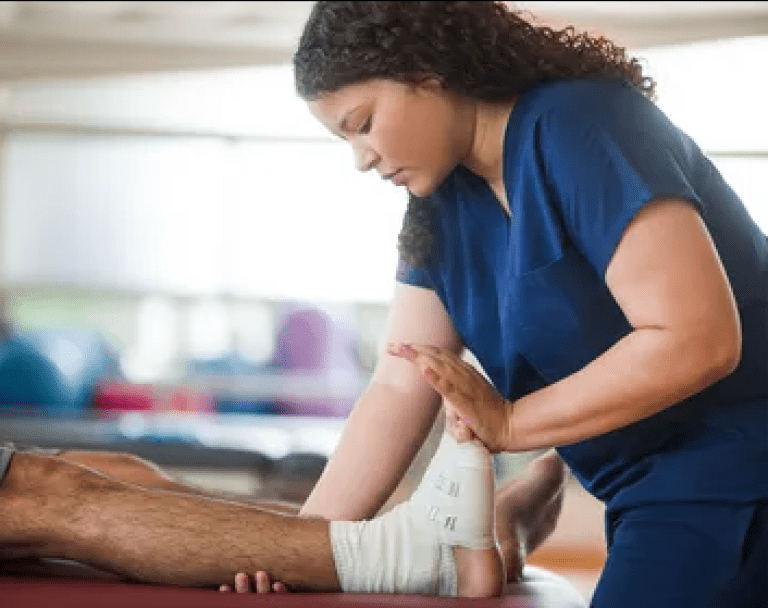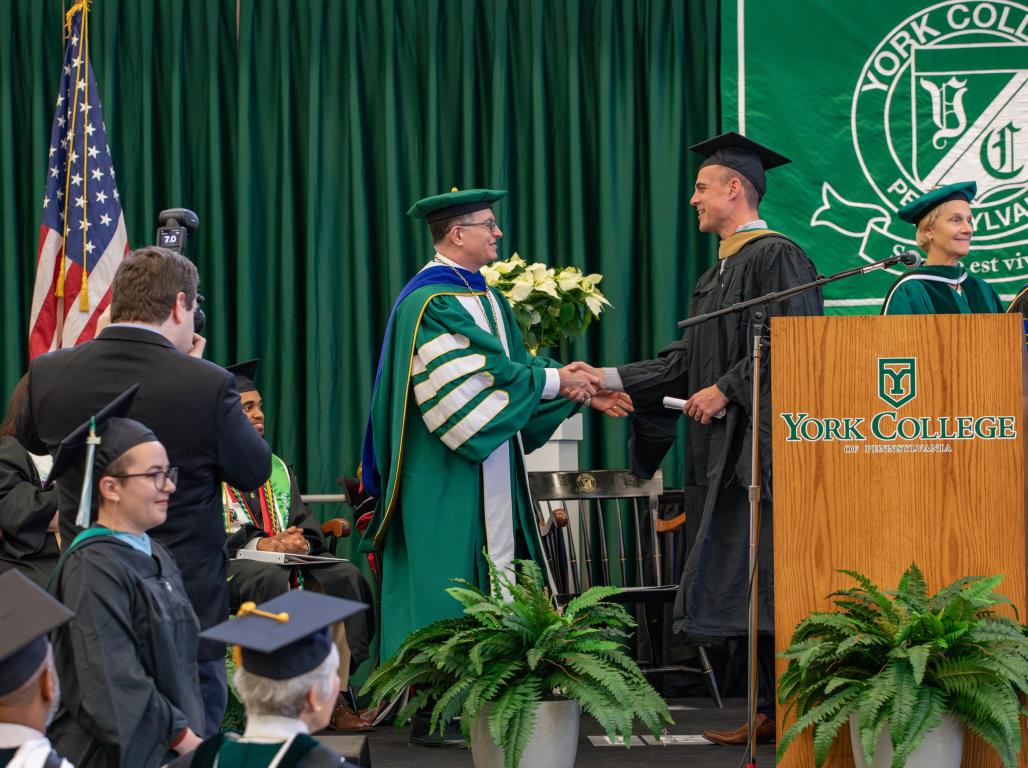
Learn how to become a credentialed physical therapist (PT) who helps patients recover from injury using expertise in movement and exercise. From which major to choose to where to get licensed, we’ll go over the required steps to take toward a physical therapy career path.
What is a Physical Therapist?
Physical therapy is a subset of sports medicine, a broad discipline concerned with movement and exercise.
Physical therapists are practitioners trained at the doctoral level who use their education and experience to help patients heal from physical injury that occurred as a result of sport, exercise, accident, or illness. Credentialed physical therapists can serve clients in private practice settings or as an employee of an organization, such as a sports team.
What Do Physical Therapists Do?
Physical therapists, or Doctors of Physical Therapy (DPTs), diagnose patients with issues related to pain, range of motion, and physical ability. Based on the patient’s needs, they then develop treatment plans that include scheduled movement sessions and prescribed exercise. Patients most often seek treatment by a physical therapist after being referred by a primary care or general practice physician.
Physical problems that are diagnosed and evaluated by physical therapists include breaks, strains, sprains, neurological symptoms, or disease-related symptoms. During the initial diagnosis, the physical therapist observes the patient’s range of motion, pain level, and severity of the injury. Utilizing stretching sessions, special equipment, and other techniques, the PT conducts hands-on treatment to help the patient regain, maintain, or improve their abilities.
In addition to learning how to execute a tailored plan of care, physical therapists are knowledgeable in how to record and evaluate patient progress in medical history documentation.
Where Do Physical Therapists Work?
According to the Bureau of Labor Statistics, more physical therapists work in medical offices than in other settings. Physical therapists can also be employed by:
- Fitness and wellness organizations
- Schools or educational institutions
- Extended care centers
- Hospitals and inpatient settings
- Rehab facilities
- Nursing homes
- In-home healthcare organizations
Because physical therapists can work for themselves in private practice or work for a variety of employers and purposes, they can create the career niche they connect with the most.
How to Become a Physical Therapist
To work as a physical therapist in the U.S., you must follow a specific path of education and professional certification. This path includes at least four essential experiences:
- Earn an undergraduate degree at an accredited institution
- Complete a Doctor of Physical Therapy (DPT) degree program at an accredited institution
- Pass the National Physical Therapy Examination (NPTE)
- Obtain licensure to practice in your state or locality
These four items are the basic requirements to become a physical therapist. Let’s take a closer look at what this process entails.
How Many Years Does It Take to Become a Physical Therapist?
The experiential and educational requirements for professional physical therapists usually take around seven years to complete.
During this time, you’ll earn an undergraduate degree as well as enroll in a three-year Doctor of Physical Therapy graduate program. Pursuing certification in a specialty, board certification, or a clinical residency fellowship can extend time frames as you gain experience and licensure after graduation.
What Undergraduate Degree Should You Choose to Become a Physical Therapist?
To enroll in the graduate and certification programs necessary to become a practicing PT, students should select an undergraduate major that closely aligns with the prerequisites for Doctor of Physical Therapy degrees. When researching a program, you’ll want to pay attention to Bachelor of Arts or Bachelor of Science degrees where the curriculum includes topics such as:
- Health
- Physics
- Anatomy and Physiology
- Kinesiology
- Nutrition
- Chemistry
- Exercise Physiology
Earning an accredited bachelor’s degree in the following subjects best prepares students for physical therapy graduate programs and careers:
- Exercise Science
- Human Performance
- Biology
- Health Professions
- Kinesiology
- Neuroscience
- Health Sciences
- Recreation
After completing a Bachelor of Science or Bachelor of Arts in one of these disciplines, you can apply to graduate school to earn a DPT degree. Entrance requirements vary depending on the school, but each program looks for hands-on experience and deeper learning in physical therapy methods and practices. York College’s B.S. in Exercise Science degree program, for example, includes applied internship experiences as excellent preparation for DPT programs.
How to Become a Physical Therapist with a Specialization
Physical therapists may treat the general public and a range of diagnoses. There are also specialties within physical therapy concerning specific populations, settings, or injury types. Practicing within a sub-field of physical therapy can often lead to higher earning potential.
Types of physical therapist specialties include:
- Sports
- Pediatrics
- Orthopedics
- Oncology
- Women’s Health
- Wound Management
- Neurology
- Geriatrics
- Clinical Electrophysiology
- Cardiovascular and Pulmonary
Through Doctor of Physical Therapy programs and professional certifications, like those offered by the American Board of Physical Therapy Specialties, physical therapists develop both generalized and specialized skills necessary to shape their practice and help various patients.
If you have a physical therapy specialist pathway in mind, seek out Doctor of Physical Therapy programs that include opportunities to gain skills or experience in your chosen field. For each specialization’s board certification requirements, you may need to complete clinical hours. Some physical therapists work in residency programs after earning their DPT to gain experience in a specialty.
Learn how to become a board-certified physical therapy specialist through the ABPTS.
How to Become Licensed as a Physical Therapist
After earning a DPT degree, you’ll need to learn what the licensure requirements are for the state you’re practicing in.
While all states require you to pass the National Physical Therapy Examination (NPTE) as part of the licensing process, other requirements vary by state. You may be required to undergo a background check, take a jurisprudence exam on your regulatory knowledge, or complete other licensure qualifications.
If you become a physical therapist in a private practice setting, you may need additional credentialing from a health insurance company to work in their network. This credentialing process often includes acquiring malpractice insurance and becoming nationally registered as a healthcare provider.
Find your state’s licensing authority to learn about your licensing process.
Outlook for Physical Therapist Careers
Demand for preventative medicine and long-term care, including the field of physical therapy, is growing as chronic health conditions affecting neuromusculoskeletal systems are diagnosed, the baby boomer population ages, and modern medical achievements help victims of life-threatening injuries enter rehabilitative physical therapy to recover.
Because of these circumstances, demand for physical therapists is projected to grow 17% through 2031, according to the Bureau of Labor Statistics (BLS), making it a solid career choice. In less densely populated or rural areas, physical therapists may be in higher demand as greater numbers of the population seek access to treatment by a DPT, and few are available.
Physical Therapist Salary
The BLS reports that physical therapists can earn a median annual wage of $95,620, with the top 10% earning more than $127,110 annually. The higher end of the salary range can be attributed to higher earning potential for physical therapy specialties and providers with years of experience in the industry.
More Career Tracks in Exercise Science, Kinesiology, and Sports Medicine
Studying science topics pertaining to physical movement and health can prepare undergraduate students for career pathways in health sciences, master’s and doctoral programs in sports medicine, kinesiology, or athletic training, as well as for physical therapy careers.
If you want to pursue a career helping others in fields like health, physical activity, and movement, the following are similar careers to DPTs:
- Physical Therapist Assistant (PTA)
- Athletic Trainer
- Doctor of Sports Medicine
- Nutritionist or Registered Dietitian (RD)
- Occupational Therapist (OT)
Physical Therapist Career Pathway at York College of Pennsylvania
Take the first step to becoming a practicing physical therapist by earning an accredited bachelor’s degree in exercise science at York College of Pennsylvania.
Our well-rounded BS in Exercise Science program ensures students gain skills that promote health and physical ability and pave the future of the field in preparation for Doctor of Physical Therapy programs and professional licensure.
Learn more about career pathways in the health sciences including physical therapy and the Myers School of Nursing and Health Professions at York College of Pennsylvania.




